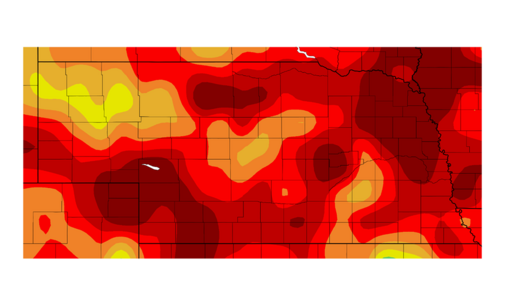Nebraska has faced two consecutive dry seasons in 2021 and 2022. The severely dry 2022 season in most of Nebraska (Figure 1) has raised questions about nitrogen application for the next year’s crop. In irrigated or dryland areas with normal production, the management practices may continue as normal, but for dryland areas with drastic yield reductions, there is potential for nitrogen fertilizer adjustment for the 2023 crop.
If corn grain yield is drastically reduced due to drought conditions affecting crop growth, then it is likely that crop nitrogen uptake was reduced as well. This often leaves a considerable amount of unused nitrate nitrogen in the soil. Therefore, it is a profitable and environmentally sound practice to sample soil to give proper credit for this residual soil nitrogen when determining fertilizer-N rates for 2023 crops.
'It is a profitable and environmentally sound practice to sample soil to give proper credit for the residual soil nitrogen when determining fertilizer-N rates for 2023 crops.'
To estimate residual nitrogen, sample soil at least 24 inches, although 36 inches or 48 inches is preferable to better capture nitrate present in the soil profile following dry conditions. These cores should be split into one-foot increments instead of mixed together into one sample to give a better understanding of where nitrate is present in the soil profile. Cores should be air dried, refrigerated or frozen if they can’t be submitted with 24 hours to a soil testing lab for soil nitrate-N analysis. A sample consisting of six to eight soil cores should be collected to represent no more than 40 acres if fields are uniform. However, drought conditions often result in uneven yields across fields depending on soil types and landscape position. In fields with soil and yield variability, consider doing the soil sampling by zones within the field to better capture the patterns of residual nitrate-N. Yield monitor data, digital soil maps and elevation are some of the data layers that could be used to identify zones for nitrate sampling. More information can be found in our extension circular, “Soil Sampling for Precision Agriculture — EC 154”.
The depth-weighted average nitrate-N concentration (parts per million) across several soil depths in the rootzone is considered in the university’s N recommendation equation. The depth-weighted concentration is calculated as the sum of the nitrate-N concentration in the zero- to two-feet depth soil sample plus 3.0 (which is the assumed nitrate concentration below two feet) divided by two. For example, if there was 9.0 ppm nitrate-N for the zero to two-feet depth, then the depth weighted average = (9.0+3.0)/2 = 6 ppm. The recommended N need is then reduced by 8 lb/ac for each ppm of the nitrate-N concentration for the zero- to four-foot depth (e.g. 6 x 8 = 48 lbs/ac N credit). More information can be found in our extension circular, “Fertilizer Suggestions For Corn”.
The timing of soil sampling for making N recommendations could be important as snowmelt and precipitation during early spring may affect N losses (especially for coarse-textured soils), resulting in under-application of pre-plant or in-season N. Collecting pre-plant soil nitrate-N samples in spring is a good practice for determining residual soil nitrate-N to be credited in N rate decisions. However, if you plan to have nitrogen application this fall, consider the following to avoid the over-application of nitrogen while reducing the potential of nitrogen loss.
- Sample soil at two-, three- or four-foot to determine residual nitrate-N to be credited in nitrogen rate calculations.
- With the potential of early harvest this year, carefully consider the risks of early N fertilizer application. Apply fertilizer-N (and manure) when the soil temperature is below 50°F at the four-inch soil depth and trending cooler to minimize nitrification losses (Check CropWatch soil temperature).
- Apply anhydrous ammonia rather than other N fertilizers.
- Limit fall application of N to silt loams, silty clay loams and finer-textured soils.
- Consider the use of nitrification inhibitors to slow the conversion of ammonium to nitrate, especially on coarse textured soils.
- Avoid fall application on wet or flooding-prone soils.
- If fall anhydrous is going to be applied, consider applying part of the total nitrogen requirement in the fall and applying the remaining in-season, preferably according to the results of pre-sidedress nitrate testing or canopy sensing.
Summary
With the two consecutive dry seasons in 2021 and 2022, there is likely a considerable amount of unused nitrogen left in the soil, which could be used for the 2023 crop. With the higher fertilizer prices, such fertility adjustments for next crop can be profitable as well as environment friendly. So, it is recommended to test your soil and account for all sources of nutrients for the next crop.

